Planning Your Trekking Atlas Mountains Morocco
Planning a trekking Atlas Mountains Morocco requires careful preparation to ensure a safe and enjoyable experience. Before embarking on your adventure, consider factors such as fitness level, trekking experience, and the duration of your trek. It is also important to choose the right season to avoid extreme weather conditions. Researching different routes and understanding their difficulty levels will help you select the most suitable one for your abilities. Lastly, don’t forget to pack essential gear and familiarize yourself with safety guidelines to make the most of your trekking experience.
Factors to Consider Before Trekking in the Atlas Mountains
When planning a trek in the Atlas Mountains of Morocco, there are several factors to consider. Firstly, one should assess their fitness level and trekking experience to choose the appropriate difficulty level. Additionally, the duration of the trek should be taken into account and aligned with one’s physical capabilities. Another crucial factor is selecting the right season to avoid extreme weather conditions. By carefully considering these factors, trekkers can ensure a safe and enjoyable experience in the stunning Atlas Mountains.
Choosing the Right Season for Trekking
The Atlas Mountains offer different trekking experiences depending on the season. Spring (March to May) and autumn (September to November) are the preferred seasons for trekking due to pleasant weather conditions. The temperatures are mild, and the valleys are lush with blooming flowers and vegetation. However, summer (June to August) can be hot, and winter (December to February) brings cold temperatures and even snow in higher altitudes. It is essential to consider these factors and choose the right season for a comfortable and safe trekking experience in the Atlas Mountains.
Essential Gear for Trekking in the Atlas Mountains Morocco
When trekking in the Atlas Mountains of Morocco, it is crucial to have the right gear to ensure a safe and enjoyable experience. Firstly, hikers should invest in appropriate clothing, including layers to adapt to changing temperatures. Sturdy and comfortable footwear is essential for tackling the rugged terrain. Other must-have gear includes a waterproof backpack, a reliable and lightweight tent, a sleeping bag suitable for colder nights, a map and compass for navigation, a first aid kit for emergencies, and sufficient food and water supplies.
Clothing and Footwear Recommendations
When trekking in the Atlas Mountains of Morocco, it’s important to dress appropriately for the changing weather conditions. Hikers should wear moisture-wicking and breathable clothing made of lightweight materials, such as merino wool or synthetic fabrics. It’s recommended to dress in layers, including a base layer, insulating mid-layer, and a waterproof outer layer. For footwear, sturdy and comfortable hiking boots are a must. They should provide ankle support and have a good grip on uneven terrain. Don’t forget to bring along extra socks to keep your feet dry and prevent blisters.
Must-Have Equipment for Safe Trekking
Having the right equipment is crucial for a safe trekking experience in the Atlas Mountains of Morocco. Here are some must-have items: a reliable backpack to carry your gear, a sturdy and comfortable pair of trekking poles for stability, a headlamp or flashlight for navigating in low-light conditions, a first aid kit to address any minor injuries, a map and compass for navigation, a multi-purpose knife or tool, a water bottle or hydration pack to stay hydrated, and a lightweight and durable tent for overnight stays. It’s also important to pack a sufficient amount of food, sunscreen, and insect repellent.
Popular Trekking Routes in the Atlas Mountains
Nestled in the stunning Atlas Mountains of Morocco, there are several popular trekking routes that offer breathtaking views and unique experiences. One of the most sought-after routes is the Toubkal Ascent, leading adventurers to the summit of Mount Toubkal, the highest peak in Morocco. Another beloved trail is the Tizi n’Test Pass Trek, renowned for its scenic vistas and encounters with traditional Berber villages. These routes provide trekkers with a chance to immerse themselves in the beauty of nature while exploring the rich cultural heritage of the Atlas Mountains.
Toubkal Ascent: Morocco’s Highest Peak
Tucked away in the stunning Atlas Mountains, the Toubkal Ascent is a truly remarkable trek. Standing tall at 4,167 meters, Mount Toubkal is not only the highest peak in Morocco but also in North Africa. The trek to the summit offers adventurers a challenging but immensely rewarding experience. As trekkers make their way up the mountain, they are treated to breathtaking views of the surrounding landscapes, including rocky terrain, lush valleys, and snow-capped peaks. The sense of achievement when reaching the summit is unparalleled, making the Toubkal Ascent an absolute must for avid hikers and nature enthusiasts.
Tizi n’Test Pass Trek: Scenic Views and Berber Villages
The Tizi n’Test Pass Trek in the Atlas Mountains offers trekkers stunning scenic views and a chance to experience the rich Berber culture. The trek takes you through rugged mountain terrain and picturesque valleys, providing breathtaking vistas of the surrounding landscapes. Along the way, you’ll have the opportunity to visit traditional Berber villages and interact with the friendly locals, gaining insights into their way of life. This trek is perfect for those seeking a mix of natural beauty and cultural immersion in the Atlas Mountains of Morocco.
Safety Tips and Guidelines for Trekking in the Atlas Mountains
When trekking in the Atlas Mountains, it’s important to prioritize safety. Here are some essential tips to keep in mind:
- Stay hydrated: Carry enough water and drink regularly to prevent dehydration, especially in the high altitudes.
- Dress appropriately: Layer your clothing to adjust to changing weather conditions. A good pair of hiking boots with ankle support is essential.
- Pack essentials: Bring a first aid kit, a map and compass, a headlamp, and a mobile phone for emergencies.
- Inform someone: Let a reliable person know about your trekking plans, including the route and estimated return time.
- Follow marked trails: Stick to established paths to avoid getting lost in remote areas.
- Beware of altitude sickness: Ascend gradually to acclimatize your body to higher altitudes. If you experience symptoms like headache, dizziness, or nausea, descend immediately.
- Bring snacks: Carry enough food and energy bars to fuel yourself throughout the trek.
- Respect nature: Leave no trace and be mindful of the environment. Dispose of waste properly and respect the wildlife.
- Check weather conditions: Before setting out, check the weather forecast and be prepared for changes in temperature and precipitation.
- Travel with a guide: Consider hiring a local guide who is familiar with the area and can provide valuable insights and assistance.
By following these safety tips and guidelines, you can have a fulfilling and safe trekking experience in the Atlas Mountains.
Altitude Sickness Prevention
Altitude sickness can be a concern when trekking in the high elevations of the Atlas Mountains. To prevent altitude sickness, it’s important to ascend gradually, allowing your body time to acclimatize to the higher altitudes. Take it slow and avoid rushing the ascent. Stay hydrated by drinking plenty of water throughout the trek. Listen to your body and pay attention to any signs of altitude sickness such as headache, dizziness, or nausea. If you experience symptoms, it’s crucial to descend to a lower altitude immediately.
Navigation and Communication in Remote Areas
Navigation and communication can be challenging in remote areas of the Atlas Mountains. It’s important to have a reliable map or GPS device to navigate through the rugged terrain. Familiarize yourself with the route before setting out to ensure you don’t get lost. Due to limited mobile network coverage, it’s advisable to carry a satellite phone or a personal locator beacon for emergencies. It’s also a good idea to inform someone of your trekking plans and expected return time so that they can raise an alarm if needed.
Cultural Immersion and Local Experiences
Immersing oneself in the local culture is an integral part of trekking in the Atlas Mountains. Interacting with the Berber communities allows trekkers to gain a deeper understanding of their traditions and way of life. Visitors can participate in traditional tea ceremonies, where they are welcomed with warm hospitality. They can also learn about Berber handicrafts, such as rug weaving and pottery making. Staying in local guesthouses or mountain huts provides an opportunity to experience authentic Berber hospitality and savor traditional Moroccan cuisine prepared with local ingredients.
Interacting with Berber Communities
To truly experience the rich culture of the Atlas Mountains, interacting with the Berber communities is a must. Trekkers will have the opportunity to engage with the locals and learn about their fascinating traditions and way of life. The warm hospitality of the Berber people is evident in their traditional tea ceremonies, where visitors are welcomed with open arms. Guests can also witness the artistry of Berber handicrafts, like rug weaving and pottery making. Staying in local guesthouses or mountain huts offers a chance to immerse oneself in the authentic Berber hospitality and indulge in delicious Moroccan cuisine prepared with local ingredients.
Traditional Cuisine and Accommodation Options
The Atlas Mountains provide trekkers with a chance to indulge in traditional Berber cuisine. Guests can savor dishes like tagine, a slow-cooked stew bursting with flavors, and couscous, a staple grain dish. Fresh ingredients like herbs, vegetables, and local meats are used to create delicious and hearty meals. For accommodation, trekkers have a range of options, including local guesthouses and mountain huts. These offer an authentic experience, allowing visitors to immerse themselves in the local culture and hospitality. Staying in these accommodations provides comfort and a sense of community while trekking through the Atlas Mountains.
Conclusion
The trekking experience in the Atlas Mountains of Morocco is a captivating adventure that offers breathtaking views, cultural immersion, and a sense of accomplishment. Whether exploring the Toubkal Ascent or discovering the scenic beauty of the Tizi n’Test Pass, trekkers will be enchanted by the stunning landscapes and warmth of the Berber communities. With careful planning and appropriate gear, trekkers can safely navigate the mountains and enjoy the local cuisine and accommodations. A trek in the Atlas Mountains is an unforgettable journey that combines nature, culture, and a true sense of adventure.
Summary of Trekking in the Atlas Mountains Experience
Trekking in the Atlas Mountains of Morocco is an exhilarating experience that combines stunning landscapes, cultural immersion, and a sense of achievement. Whether conquering Morocco’s highest peak, Toubkal, or venturing through the scenic Tizi n’Test Pass, trekkers are rewarded with breathtaking views and encounters with friendly Berber communities. With careful planning and the right gear, trekkers can navigate the mountains safely while enjoying the local cuisine and accommodations. Overall, a trek in the Atlas Mountains offers a unique blend of adventure, nature, and cultural exploration.
Additional Resources and Guides for Trekking Enthusiasts
For those who are passionate about trekking and want to explore the Atlas Mountains further, there are many additional resources and guides available to enhance their experience. Trekking enthusiasts can find detailed maps, route suggestions, and trail descriptions online or in guidebooks specifically dedicated to the Atlas Mountains. These resources can provide valuable information on the best times to visit, difficulty levels, and essential tips for a successful trek. Additionally, joining online forums and communities dedicated to trekking in Morocco can connect enthusiasts with fellow hikers, allowing for shared experiences and recommendations.
FAQs
1. Which season is best for trekking in the Atlas Mountains of Morocco?
The best seasons for trekking in the Atlas Mountains are spring (April to June) and fall (September to November) when the weather is milder.
2. What kind of physical preparation is required for trekking in the Atlas Mountains?
Trekking in the Atlas Mountains requires a good level of fitness, including cardiovascular endurance and strength training to handle varying terrains.
3. Are guided tours necessary for trekking in the Atlas Mountains, Morocco?
While not mandatory, guided tours can enhance your experience by providing local insights, navigation assistance, and ensuring safety on less-traveled paths.
4. What should I pack for a trekking adventure in the Atlas Mountains?
Essential items include sturdy hiking boots, layered clothing, a sun hat, sunscreen, a first aid kit, plenty of water, snacks, and a camera to capture stunning views.
5. Are permits or fees required for trekking in the Atlas Mountains?
Permits are not typically needed for day treks; however, certain areas may require permits or fees for camping overnight or accessing specific trails.
6. How challenging are the trails in the Atlas Mountains for beginner trekkers?
Trails vary from easy walks to more challenging hikes with steep inclines. It’s advisable to choose routes that match your fitness level and experience.
7. What wildlife can be encountered while trekking in the Atlas Mountains of Morocco?
While exploring the mountains, you may encounter Barbary macaques, various bird species like eagles and vultures, as well as smaller mammals like foxes.
8. Are there accommodation options available along trekking routes in the Atlas Mountains?
Accommodation ranges from Berber guesthouses to mountain huts or camping sites along popular routes; advanced booking is recommended during peak seasons.
9. Is it safe to drink water from natural sources while trekking in the Atlas Mountains?
It’s safer to carry bottled water or use purification methods as natural water sources can carry contaminants that may cause gastrointestinal issues.
10. What cultural experiences can be expected during a trek through the Atlas Mountains of Morocco?
Trekking through the mountains offers opportunities to meet Berber communities, witness traditional practices, enjoy local cuisine, and learn about ancient customs.



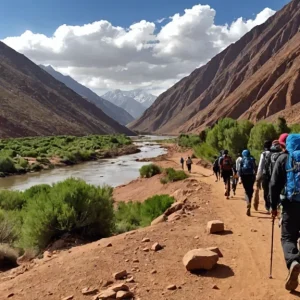
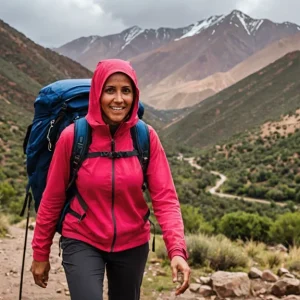
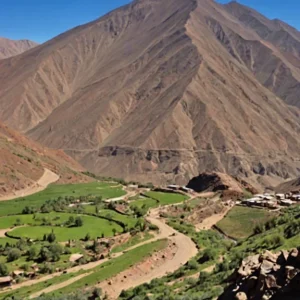
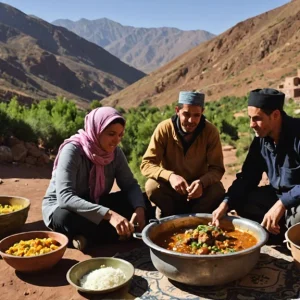
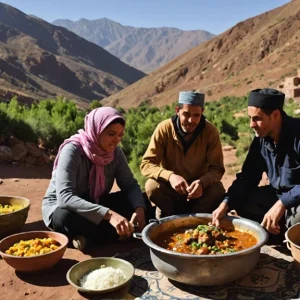
Comment (0)